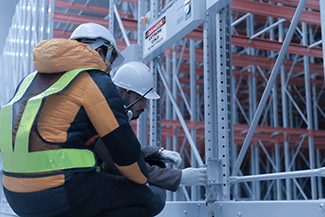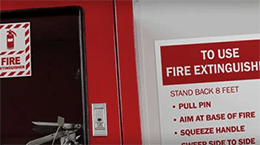OSHA Recommendations for Cold Stress Prevention

Why Is Winter Safety Signage and PPE Important for Workers?
As the temperatures continue to drop and the frost sets in, the realization that winter is here has become clearer. The question of safety signs, personal protective equipment (PPE), and their role in protecting workers should be at the forefront of discussions during the winter months, especially for those working outdoors.
While the right PPE can prevent injuries, signs are essential for guiding workers through frosty environments where safety takes precedence. Many of these measures tie directly into cold stress prevention, which OSHA highlights through resources such as the OSHA cold weather chart and broader OSHA cold weather safety guidelines.
In 2020, the U.S. Bureau of Labor Statistics (BLS) reported 53 worker deaths due to exposure from cold environments. 22 of those deaths occurred in areas where ice, sleet, and snow were present. These statistics highlight the critical importance of proactive measures in ensuring worker safety. By prioritizing effective signage, proper equipment, and strong cold stress prevention practices, employers can significantly reduce risks associated with winter work conditions.
What is Cold Stress?
Cold stress is a condition that occurs when the body can no longer maintain its normal temperature. When the body is unable to warm itself, serious cold-related illnesses and injuries can occur, including permanent tissue damage and death. Here are four types of cold stress:
- Trench foot—Occurs when the feet are exposed to prolonged wet and cold conditions.
- Frostbite—Occurs when the skin and tissue freezes
- Hypothermia—Occurs when the normal body temperature (98.6°F) drops to less than 95°F.
- Chilblains—Caused by the repeated exposure of skin to temperatures just above freezing to as high as 60°F.
Understanding these conditions is a crucial part of cold stress prevention and supporting OSHA cold weather safety measures in the workplace.
7 Tips from OSHA to Support Cold Stress Prevention and Worker Safety
Training on the signs of cold stress and other safe work practices are important steps to cold stress prevention. Here are seven tips from the Occupational Safety and Health Administration (OSHA) to protect worker safety:
1. Train employees on the symptoms of cold stressBeing trained on what type of injuries can occur due to cold weather is important as it can potentially save a life and prevent permanent damage to one's body. Here are the four types of cold-related injuries, their symptoms, and what to do in case of emergency:
- Trench foot—Symptoms of trench foot are redness of the skin, numbness, tingling, pain, swelling, leg cramps, blisters, bleeding under the skin, and Gangrene. If any of these symptoms occur:
- Call 911 immediately
- Remove wet shoes and socks
- Elevate feet and avoid walking on them
- Frostbite—Symptoms of frostbite are reddened skin that develops grayish-white patches in the fingers, toes, nose, or ear lobes; tingling, aching, a loss of feeling, firm/hard, and blisters may occur in the affected areas. If any of these symptoms occur, get to a warm area as soon as possible. Protect the frostbitten area with a loosely wrapped dry cloth and protect the area from contact until medical help arrives. Give warm sweetened drinks if alert.
- Hypothermia—Symptoms of hypothermia are uncontrollable shivering, loss of coordination, confusion, slurred speech, heart rate/breathing, unconsciousness, and possibly death. Should any of these symptoms occur:
- Call 911 immediately
- Move the worker to a warm area
- Remove any wet clothing and replace with dry clothing
- Wrap their entire body in layers of blankets.
- If alert, provide warm sweetened drinks to help increase the body temperature.
- Chilblains—Symptoms of chilblains are redness, itching, possible blistering, inflammation, and ulceration in severe cases. Should any of these symptoms arise,
- Apply first aid by warming the skin
- Clean and cover any blisters or ulcers
- Use corticosteroid cream for any itching and swelling
 2. Provide workers with personal protective equipment to protect themselves from the elements
2. Provide workers with personal protective equipment to protect themselves from the elements Outdoor workers exposed to cold and windy conditions below 32 degrees Fahrenheit are more susceptible to cold stress. Employers are required to provide PPE by OSHA standards to protect workers' safety and health. OSHA suggests workers wear:
- Thermal wear
- Wool
- Silk or polypropylene
- An inner layers of clothing that will hold more body heat than cotton
- A middle layer of wool or synthetic to provide insulation even when wet
- An outer layer to protect from wind and rain
In limited cases specified in the 29 CFR 1910.32 standard, there are exceptions to the requirement for employers to provide PPE to workers.
3. Develop a plan to identify potential hazards and the safety measures that will be used to protect workersExtreme weather conditions can pose risks for workers, and certain safety measures must be followed to ensure that all employees can work safely. People who work outdoors are exposed to all kinds of elements year-round, winter in particular has its own weather-specific hazards that they should receive training on in order to identify and prevent incidents from occurring. Slippery surfaces and roads, windy conditions, and downed power lines are common hazards, and placing safety signs in these areas will help prevent future injury are some examples of these hazards.
Safety signage plays a crucial role in communicating potential dangers and guiding workers in hazardous conditions. Clear, visible signs should be strategically placed to inform workers of risks such as icy pathways, strong winds, or low visibility. These signs not only raise awareness but also serve as reminders for workers to follow safety protocols, such as wearing appropriate PPE and staying alert. Using reflective materials for signs can enhance visibility in low-light conditions, further ensuring that workers are informed and prepared to handle the challenges presented by winter weather.
4. Scheduling maintenance and repair jobs for warmer monthsBy limiting the amount of exposure to cold elements, it reduces the risk of cold stress.
5. Provide warm areas and liquids for use during break periodsIt is important to stay hydrated, even in cold weather conditions. Drinking plenty of water helps keep the body nourished. Here is a list of other drinks that can help keep workers warm while in the field:
- Sports drinks
- Hot water with lemon and honey
- Hot tea
- Bone broth
Symptoms to watch out for are shivering, redness, itching, blistering, leg cramps, tingling, and swelling as these are signs of frostbite, chilblains, hypothermia, and trench foot.
7. Acclimatize workers to cold climatesOn average, it takes the body 2-3 weeks to adapt to inclement weather conditions. Similar to warm environments, it is important to gradually increase the amount of time workers spend in these conditions so they can adjust safely. Allow frequent breaks in warm areas to build up a tolerance for working in a cold environment.
DuraLabel Resources for OSHA Cold Weather Safety
Cold stress can affect anyone, so it is important to be aware of the signs and what to do should an incident arise that requires medical attention or intervention. Training employees on what to do in an emergency is crucial in the prevention of cold stress injuries.
Visual communication significantly enhances employee safety. Identifying common hazards within facilities or in the field enables teams to navigate their workspaces safely and efficiently. Safety signs and labels serve as crucial reminders of potential dangers to help employees remain vigilant. Organizations can create OSHA-compliant signs and labels with a reliable industrial sign and label printer. The DuraLabel Kodiak Max Industrial Sign and Label Print System is the perfect all-in-one print system that can create durable signs and labels able to withstand extreme conditions, including freezing temperatures.
DuraLabel’s free OSHA Signage Quick Start Guide helps you create OSHA/ANSI compliant safety signs. The free guide helps readers understand the relevant regulations and standards to enhance safety and efficiency.
Want more help creating an OSHA-compliant environment? Give us a call today at 1-888-902-2148 and one of our experts will assist you.
Read Next:
Related Resources

OSHA Fire Safety Rules That Could Save Lives and Property
How Can Businesses Prevent Workplace Fire Hazards? In any workplace, fire safety is not just a box to tick—it ...
Read
The Importance of Chemical Risk Assessments
Chemicals are in use in workplaces every day. It is important to follow and maintain chemical safety for ...
Read
What does it take for an EPA Cleanup?
The U.S. Environmental Protection Agency is celebrating 20 years of Superfund success. We talk with EPA ...
Read.png)





